Reflective Report on Customer Buying Decisions and Motivation
VerifiedAdded on 2020/02/14
|12
|2271
|290
Report
AI Summary
This reflective report delves into the multifaceted realm of customer buying decisions, examining the various influences that shape consumer behavior. The report begins by identifying key factors that impact purchasing choices, such as marketing campaigns, economic conditions, personal preferences, group influence, and purchasing power. It then transitions into an exploration of motivation theories, including Alderfer's ERG theory, Vroom's Expectancy theory, and Adam's Equity theory, with a particular focus on Maslow's Hierarchy of Needs. The report further analyzes the application of SMART objectives to enhance customer loyalty and satisfaction, detailing each element of the SMART framework: Specific, Measurable, Attainable, Relevant, and Time-bound. Through this comprehensive analysis, the report provides valuable insights into the dynamics of customer decision-making processes and the strategies businesses can employ to foster customer loyalty.

REFLECTIVE REPORT
Paraphrase This Document
Need a fresh take? Get an instant paraphrase of this document with our AI Paraphraser
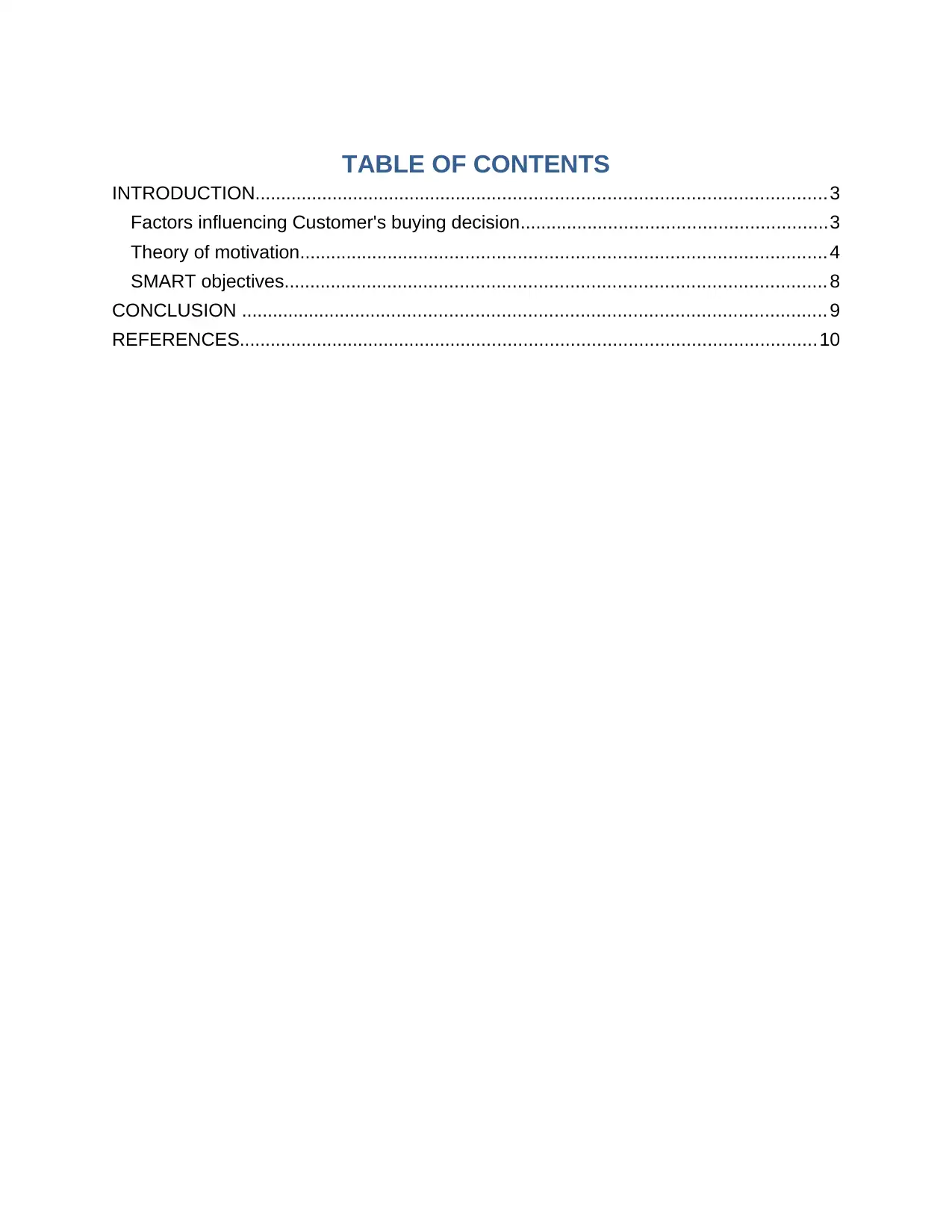
TABLE OF CONTENTS
INTRODUCTION..............................................................................................................3
Factors influencing Customer's buying decision...........................................................3
Theory of motivation.....................................................................................................4
SMART objectives........................................................................................................ 8
CONCLUSION ................................................................................................................ 9
REFERENCES...............................................................................................................10
INTRODUCTION..............................................................................................................3
Factors influencing Customer's buying decision...........................................................3
Theory of motivation.....................................................................................................4
SMART objectives........................................................................................................ 8
CONCLUSION ................................................................................................................ 9
REFERENCES...............................................................................................................10
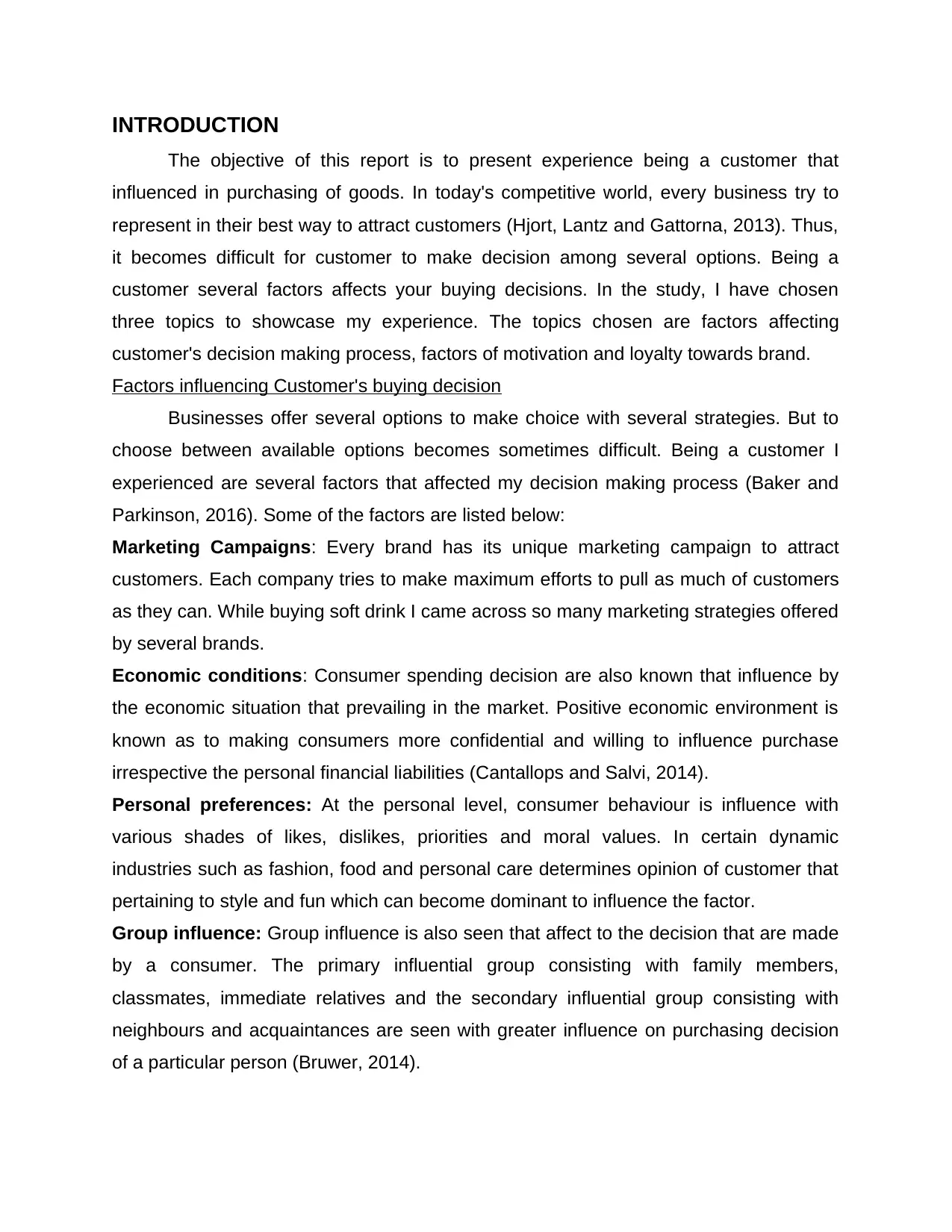
INTRODUCTION
The objective of this report is to present experience being a customer that
influenced in purchasing of goods. In today's competitive world, every business try to
represent in their best way to attract customers (Hjort, Lantz and Gattorna, 2013). Thus,
it becomes difficult for customer to make decision among several options. Being a
customer several factors affects your buying decisions. In the study, I have chosen
three topics to showcase my experience. The topics chosen are factors affecting
customer's decision making process, factors of motivation and loyalty towards brand.
Factors influencing Customer's buying decision
Businesses offer several options to make choice with several strategies. But to
choose between available options becomes sometimes difficult. Being a customer I
experienced are several factors that affected my decision making process (Baker and
Parkinson, 2016). Some of the factors are listed below:
Marketing Campaigns: Every brand has its unique marketing campaign to attract
customers. Each company tries to make maximum efforts to pull as much of customers
as they can. While buying soft drink I came across so many marketing strategies offered
by several brands.
Economic conditions: Consumer spending decision are also known that influence by
the economic situation that prevailing in the market. Positive economic environment is
known as to making consumers more confidential and willing to influence purchase
irrespective the personal financial liabilities (Cantallops and Salvi, 2014).
Personal preferences: At the personal level, consumer behaviour is influence with
various shades of likes, dislikes, priorities and moral values. In certain dynamic
industries such as fashion, food and personal care determines opinion of customer that
pertaining to style and fun which can become dominant to influence the factor.
Group influence: Group influence is also seen that affect to the decision that are made
by a consumer. The primary influential group consisting with family members,
classmates, immediate relatives and the secondary influential group consisting with
neighbours and acquaintances are seen with greater influence on purchasing decision
of a particular person (Bruwer, 2014).
The objective of this report is to present experience being a customer that
influenced in purchasing of goods. In today's competitive world, every business try to
represent in their best way to attract customers (Hjort, Lantz and Gattorna, 2013). Thus,
it becomes difficult for customer to make decision among several options. Being a
customer several factors affects your buying decisions. In the study, I have chosen
three topics to showcase my experience. The topics chosen are factors affecting
customer's decision making process, factors of motivation and loyalty towards brand.
Factors influencing Customer's buying decision
Businesses offer several options to make choice with several strategies. But to
choose between available options becomes sometimes difficult. Being a customer I
experienced are several factors that affected my decision making process (Baker and
Parkinson, 2016). Some of the factors are listed below:
Marketing Campaigns: Every brand has its unique marketing campaign to attract
customers. Each company tries to make maximum efforts to pull as much of customers
as they can. While buying soft drink I came across so many marketing strategies offered
by several brands.
Economic conditions: Consumer spending decision are also known that influence by
the economic situation that prevailing in the market. Positive economic environment is
known as to making consumers more confidential and willing to influence purchase
irrespective the personal financial liabilities (Cantallops and Salvi, 2014).
Personal preferences: At the personal level, consumer behaviour is influence with
various shades of likes, dislikes, priorities and moral values. In certain dynamic
industries such as fashion, food and personal care determines opinion of customer that
pertaining to style and fun which can become dominant to influence the factor.
Group influence: Group influence is also seen that affect to the decision that are made
by a consumer. The primary influential group consisting with family members,
classmates, immediate relatives and the secondary influential group consisting with
neighbours and acquaintances are seen with greater influence on purchasing decision
of a particular person (Bruwer, 2014).
⊘ This is a preview!⊘
Do you want full access?
Subscribe today to unlock all pages.

Trusted by 1+ million students worldwide
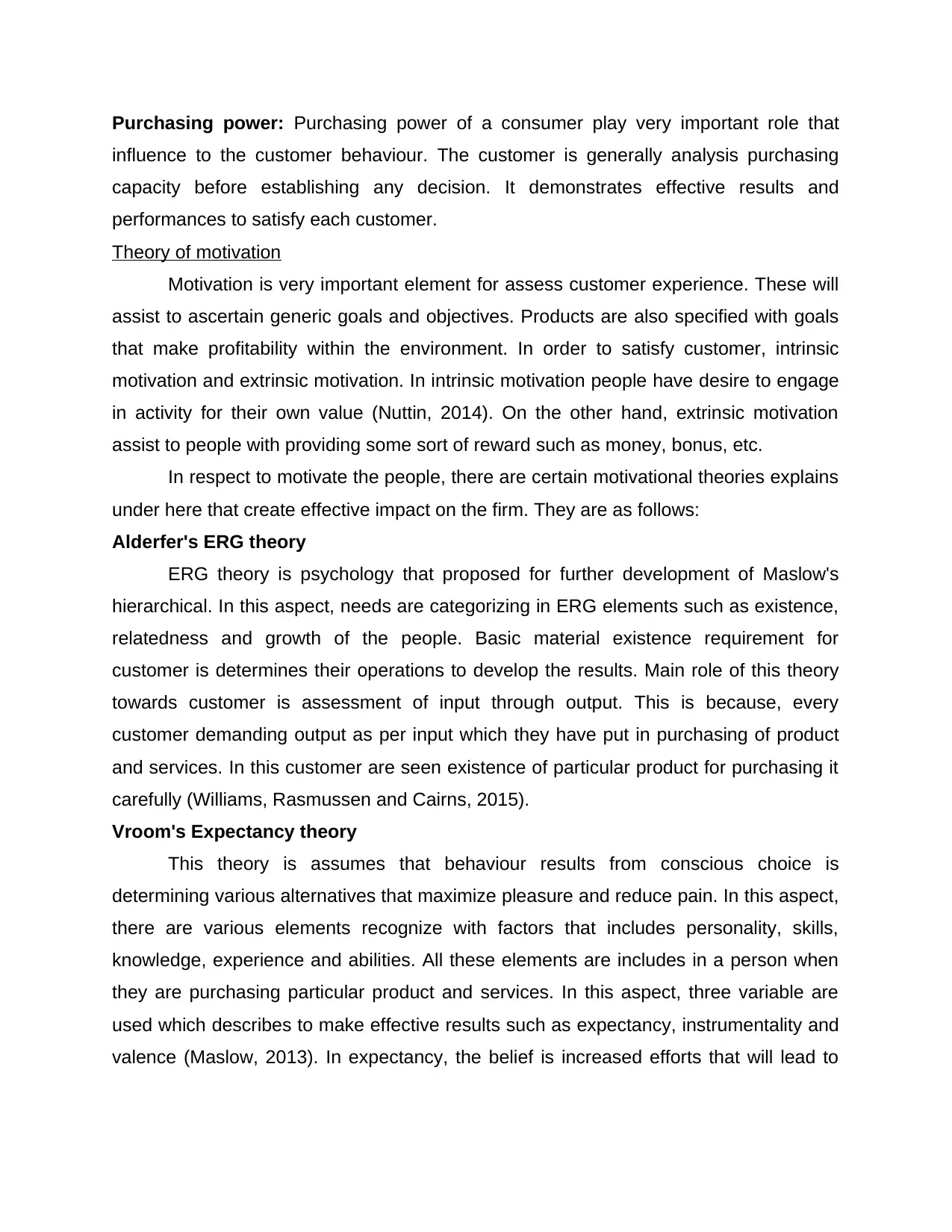
Purchasing power: Purchasing power of a consumer play very important role that
influence to the customer behaviour. The customer is generally analysis purchasing
capacity before establishing any decision. It demonstrates effective results and
performances to satisfy each customer.
Theory of motivation
Motivation is very important element for assess customer experience. These will
assist to ascertain generic goals and objectives. Products are also specified with goals
that make profitability within the environment. In order to satisfy customer, intrinsic
motivation and extrinsic motivation. In intrinsic motivation people have desire to engage
in activity for their own value (Nuttin, 2014). On the other hand, extrinsic motivation
assist to people with providing some sort of reward such as money, bonus, etc.
In respect to motivate the people, there are certain motivational theories explains
under here that create effective impact on the firm. They are as follows:
Alderfer's ERG theory
ERG theory is psychology that proposed for further development of Maslow's
hierarchical. In this aspect, needs are categorizing in ERG elements such as existence,
relatedness and growth of the people. Basic material existence requirement for
customer is determines their operations to develop the results. Main role of this theory
towards customer is assessment of input through output. This is because, every
customer demanding output as per input which they have put in purchasing of product
and services. In this customer are seen existence of particular product for purchasing it
carefully (Williams, Rasmussen and Cairns, 2015).
Vroom's Expectancy theory
This theory is assumes that behaviour results from conscious choice is
determining various alternatives that maximize pleasure and reduce pain. In this aspect,
there are various elements recognize with factors that includes personality, skills,
knowledge, experience and abilities. All these elements are includes in a person when
they are purchasing particular product and services. In this aspect, three variable are
used which describes to make effective results such as expectancy, instrumentality and
valence (Maslow, 2013). In expectancy, the belief is increased efforts that will lead to
influence to the customer behaviour. The customer is generally analysis purchasing
capacity before establishing any decision. It demonstrates effective results and
performances to satisfy each customer.
Theory of motivation
Motivation is very important element for assess customer experience. These will
assist to ascertain generic goals and objectives. Products are also specified with goals
that make profitability within the environment. In order to satisfy customer, intrinsic
motivation and extrinsic motivation. In intrinsic motivation people have desire to engage
in activity for their own value (Nuttin, 2014). On the other hand, extrinsic motivation
assist to people with providing some sort of reward such as money, bonus, etc.
In respect to motivate the people, there are certain motivational theories explains
under here that create effective impact on the firm. They are as follows:
Alderfer's ERG theory
ERG theory is psychology that proposed for further development of Maslow's
hierarchical. In this aspect, needs are categorizing in ERG elements such as existence,
relatedness and growth of the people. Basic material existence requirement for
customer is determines their operations to develop the results. Main role of this theory
towards customer is assessment of input through output. This is because, every
customer demanding output as per input which they have put in purchasing of product
and services. In this customer are seen existence of particular product for purchasing it
carefully (Williams, Rasmussen and Cairns, 2015).
Vroom's Expectancy theory
This theory is assumes that behaviour results from conscious choice is
determining various alternatives that maximize pleasure and reduce pain. In this aspect,
there are various elements recognize with factors that includes personality, skills,
knowledge, experience and abilities. All these elements are includes in a person when
they are purchasing particular product and services. In this aspect, three variable are
used which describes to make effective results such as expectancy, instrumentality and
valence (Maslow, 2013). In expectancy, the belief is increased efforts that will lead to
Paraphrase This Document
Need a fresh take? Get an instant paraphrase of this document with our AI Paraphraser

enhance in particular customer towards product and services. It is affected through
different things such as right resources, right skills and necessary support. Further,
instrumentality is determining as belief which need to be perform well to create valued
outcomes in areas for that product and service. It creating degree which placed at first
level outcome and it leads to second level results. It includes clear understanding of the
relationship between input and getting output as well (Olafsen, Halvari and Deci, 2015).
Trust in the customer make towards decision on getting outcomes from products. At
last, valence is creating importance for every individual who are place on expected
outcome. For instance, if someone motivated through money, they are not value to
offers additional time out. These three elements are very important to choose efforts for
performance expectancy.
Adam's Equity theory
This theory is based on idea in which customer are motivated through fairness.
Beside this, particular group of person is comparing themselves with whole population
within the market that make self-inside, self-outside, other-inside and other-outside.
With the help of experience, the current organisation can make effective results. This
Illustration 1: Vroom's Expectancy theory
Source: (Nuttin, 2014)
different things such as right resources, right skills and necessary support. Further,
instrumentality is determining as belief which need to be perform well to create valued
outcomes in areas for that product and service. It creating degree which placed at first
level outcome and it leads to second level results. It includes clear understanding of the
relationship between input and getting output as well (Olafsen, Halvari and Deci, 2015).
Trust in the customer make towards decision on getting outcomes from products. At
last, valence is creating importance for every individual who are place on expected
outcome. For instance, if someone motivated through money, they are not value to
offers additional time out. These three elements are very important to choose efforts for
performance expectancy.
Adam's Equity theory
This theory is based on idea in which customer are motivated through fairness.
Beside this, particular group of person is comparing themselves with whole population
within the market that make self-inside, self-outside, other-inside and other-outside.
With the help of experience, the current organisation can make effective results. This
Illustration 1: Vroom's Expectancy theory
Source: (Nuttin, 2014)
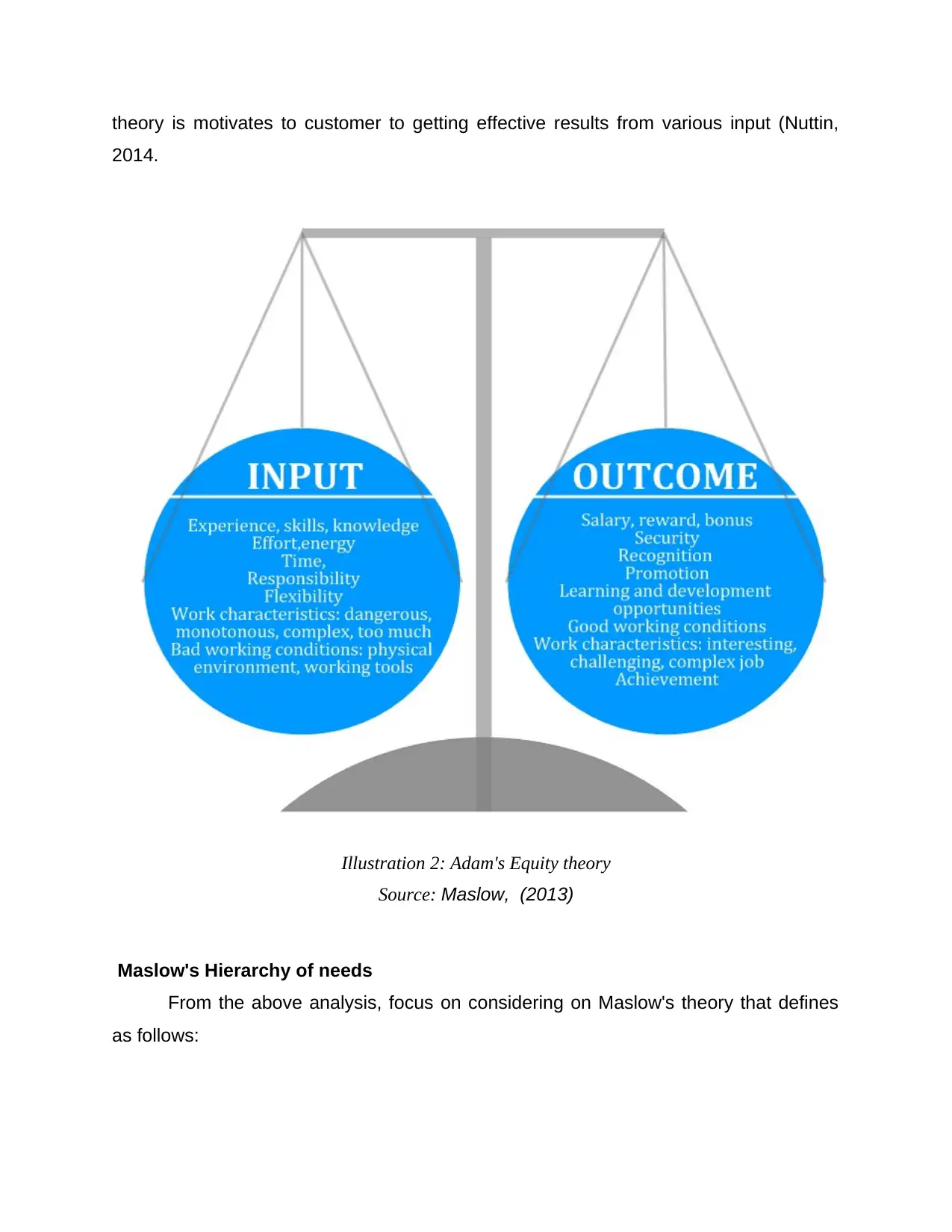
theory is motivates to customer to getting effective results from various input (Nuttin,
2014.
Maslow's Hierarchy of needs
From the above analysis, focus on considering on Maslow's theory that defines
as follows:
Illustration 2: Adam's Equity theory
Source: Maslow, (2013)
2014.
Maslow's Hierarchy of needs
From the above analysis, focus on considering on Maslow's theory that defines
as follows:
Illustration 2: Adam's Equity theory
Source: Maslow, (2013)
⊘ This is a preview!⊘
Do you want full access?
Subscribe today to unlock all pages.

Trusted by 1+ million students worldwide
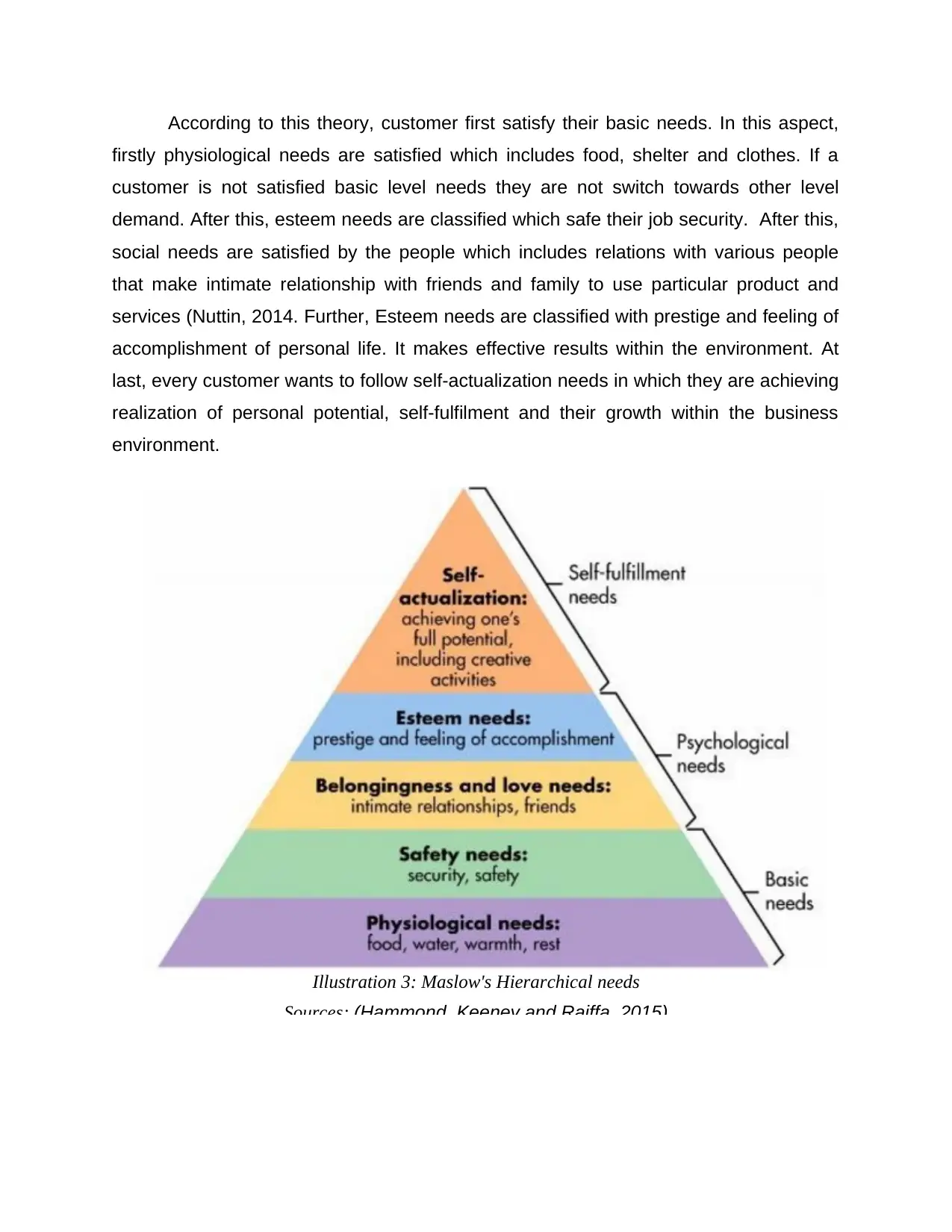
According to this theory, customer first satisfy their basic needs. In this aspect,
firstly physiological needs are satisfied which includes food, shelter and clothes. If a
customer is not satisfied basic level needs they are not switch towards other level
demand. After this, esteem needs are classified which safe their job security. After this,
social needs are satisfied by the people which includes relations with various people
that make intimate relationship with friends and family to use particular product and
services (Nuttin, 2014. Further, Esteem needs are classified with prestige and feeling of
accomplishment of personal life. It makes effective results within the environment. At
last, every customer wants to follow self-actualization needs in which they are achieving
realization of personal potential, self-fulfilment and their growth within the business
environment.
Illustration 3: Maslow's Hierarchical needs
Sources: (Hammond, Keeney and Raiffa, 2015)
firstly physiological needs are satisfied which includes food, shelter and clothes. If a
customer is not satisfied basic level needs they are not switch towards other level
demand. After this, esteem needs are classified which safe their job security. After this,
social needs are satisfied by the people which includes relations with various people
that make intimate relationship with friends and family to use particular product and
services (Nuttin, 2014. Further, Esteem needs are classified with prestige and feeling of
accomplishment of personal life. It makes effective results within the environment. At
last, every customer wants to follow self-actualization needs in which they are achieving
realization of personal potential, self-fulfilment and their growth within the business
environment.
Illustration 3: Maslow's Hierarchical needs
Sources: (Hammond, Keeney and Raiffa, 2015)
Paraphrase This Document
Need a fresh take? Get an instant paraphrase of this document with our AI Paraphraser

SMART objectives
SMART objective for particular customer is defines as follows:
Specific: The goal should be set in specific areas for achievement by customer. In this
aspect, loyalty make to customer for ascertain effective results and outcomes. For
making loyalty, customer are establishes, creates and make results for qualitative
products and services which can be support to goals and objectives in effective manner.
In specific element strategy, location and reason is defines that make simple goal and
objective (Bjerke and Renger, 2017). Hence, customer loyalty is creating for attainment
of targets and results.
Measurable: Further element of SMART objective is considering is measurement which
demonstrate measure progress of particular person through measurement of their
goals. With using quantifiable outcomes, customer can measure their outcomes for
using particular product and services. In this aspect, customer are also asks from other
people towards particular product and services before purchasing it. In measurement,
metrics and milestone is defines with effective percentage which shows effective results
at workplace (Hewitt-Taylor, 2013). As per percentage, customer loyalty has been
address that need to be taken for attain targets and results.
Attainable: Goal of customer experiences are need to be realistic. It is based on
available resources and existing constraints. In this aspect, attainment of target can be
considering as per customer view. It will make sure that customers enhances their
purchasing when they are buying again and again. With delivering qualitative products
and services, resources are also measures for change process as well. In addition to
this, in this element skills and tools are determining that is used by customer
(Hammond, Keeney and Raiffa, 2015). This is because, with skills and tools, customer
can attain their results and performances effectively. Hence, objectives can easily
develops within the business environment.
Relevant: In this stage, goal is aligns with objectives with another person experience
that make consideration effective. In this aspect, every customer has responsibilities to
check relevancy of goals and objectives that are frame to provide effective results. With
the help of relevancy, objectives can be made with developing customer loyalty. In order
SMART objective for particular customer is defines as follows:
Specific: The goal should be set in specific areas for achievement by customer. In this
aspect, loyalty make to customer for ascertain effective results and outcomes. For
making loyalty, customer are establishes, creates and make results for qualitative
products and services which can be support to goals and objectives in effective manner.
In specific element strategy, location and reason is defines that make simple goal and
objective (Bjerke and Renger, 2017). Hence, customer loyalty is creating for attainment
of targets and results.
Measurable: Further element of SMART objective is considering is measurement which
demonstrate measure progress of particular person through measurement of their
goals. With using quantifiable outcomes, customer can measure their outcomes for
using particular product and services. In this aspect, customer are also asks from other
people towards particular product and services before purchasing it. In measurement,
metrics and milestone is defines with effective percentage which shows effective results
at workplace (Hewitt-Taylor, 2013). As per percentage, customer loyalty has been
address that need to be taken for attain targets and results.
Attainable: Goal of customer experiences are need to be realistic. It is based on
available resources and existing constraints. In this aspect, attainment of target can be
considering as per customer view. It will make sure that customers enhances their
purchasing when they are buying again and again. With delivering qualitative products
and services, resources are also measures for change process as well. In addition to
this, in this element skills and tools are determining that is used by customer
(Hammond, Keeney and Raiffa, 2015). This is because, with skills and tools, customer
can attain their results and performances effectively. Hence, objectives can easily
develops within the business environment.
Relevant: In this stage, goal is aligns with objectives with another person experience
that make consideration effective. In this aspect, every customer has responsibilities to
check relevancy of goals and objectives that are frame to provide effective results. With
the help of relevancy, objectives can be made with developing customer loyalty. In order

to make sure that tools and skills are helpful for attainment of goals, overall experience
of customer will be develops. With undertaking roles and responsibilities, relevancy has
been measure in environment (Pulakos, Hanson and Moye, 2015.).
Time bound: Every goal and objectives is aligned with time bound. In this aspect,
objectives includes different types of activities which completing with time frame. In this
aspect, deadline can be meet which defines ending strategy to enhance experience of
customer. This element assist to make customer loyalty, through making time frame for
accomplish each activity. Hence, overall results will be develops in effective way. As
results, targets and goals are achieved easily.
CONCLUSION
From the above report, it could be articulated that there are various factors which
create impact on customer buying decision. In this aspect, Marketing Campaigns,
Economic conditions, Personal preferences, Group influence and Purchasing power
included in report. Furthermore, report also concluded about different types of
motivational theory which assist to find motivation of customer in their purchasing. At
last, it summarised about SMART objective towards customer loyalty in the enterprise
which is based on five elements such as specific, measurable, achievable, relevancy
and time frame.
of customer will be develops. With undertaking roles and responsibilities, relevancy has
been measure in environment (Pulakos, Hanson and Moye, 2015.).
Time bound: Every goal and objectives is aligned with time bound. In this aspect,
objectives includes different types of activities which completing with time frame. In this
aspect, deadline can be meet which defines ending strategy to enhance experience of
customer. This element assist to make customer loyalty, through making time frame for
accomplish each activity. Hence, overall results will be develops in effective way. As
results, targets and goals are achieved easily.
CONCLUSION
From the above report, it could be articulated that there are various factors which
create impact on customer buying decision. In this aspect, Marketing Campaigns,
Economic conditions, Personal preferences, Group influence and Purchasing power
included in report. Furthermore, report also concluded about different types of
motivational theory which assist to find motivation of customer in their purchasing. At
last, it summarised about SMART objective towards customer loyalty in the enterprise
which is based on five elements such as specific, measurable, achievable, relevancy
and time frame.
⊘ This is a preview!⊘
Do you want full access?
Subscribe today to unlock all pages.

Trusted by 1+ million students worldwide
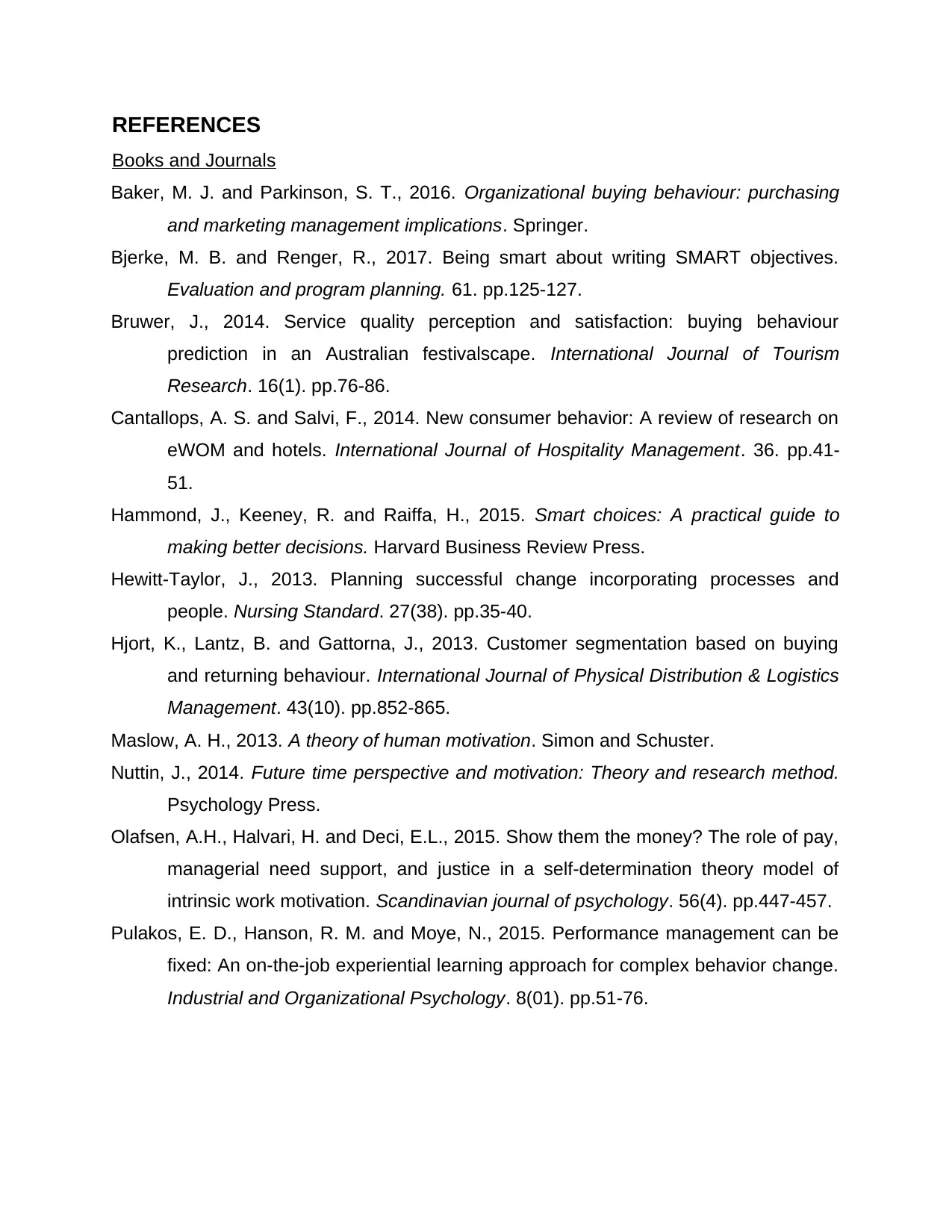
REFERENCES
Books and Journals
Baker, M. J. and Parkinson, S. T., 2016. Organizational buying behaviour: purchasing
and marketing management implications. Springer.
Bjerke, M. B. and Renger, R., 2017. Being smart about writing SMART objectives.
Evaluation and program planning. 61. pp.125-127.
Bruwer, J., 2014. Service quality perception and satisfaction: buying behaviour
prediction in an Australian festivalscape. International Journal of Tourism
Research. 16(1). pp.76-86.
Cantallops, A. S. and Salvi, F., 2014. New consumer behavior: A review of research on
eWOM and hotels. International Journal of Hospitality Management. 36. pp.41-
51.
Hammond, J., Keeney, R. and Raiffa, H., 2015. Smart choices: A practical guide to
making better decisions. Harvard Business Review Press.
Hewitt-Taylor, J., 2013. Planning successful change incorporating processes and
people. Nursing Standard. 27(38). pp.35-40.
Hjort, K., Lantz, B. and Gattorna, J., 2013. Customer segmentation based on buying
and returning behaviour. International Journal of Physical Distribution & Logistics
Management. 43(10). pp.852-865.
Maslow, A. H., 2013. A theory of human motivation. Simon and Schuster.
Nuttin, J., 2014. Future time perspective and motivation: Theory and research method.
Psychology Press.
Olafsen, A.H., Halvari, H. and Deci, E.L., 2015. Show them the money? The role of pay,
managerial need support, and justice in a self‐determination theory model of
intrinsic work motivation. Scandinavian journal of psychology. 56(4). pp.447-457.
Pulakos, E. D., Hanson, R. M. and Moye, N., 2015. Performance management can be
fixed: An on-the-job experiential learning approach for complex behavior change.
Industrial and Organizational Psychology. 8(01). pp.51-76.
Books and Journals
Baker, M. J. and Parkinson, S. T., 2016. Organizational buying behaviour: purchasing
and marketing management implications. Springer.
Bjerke, M. B. and Renger, R., 2017. Being smart about writing SMART objectives.
Evaluation and program planning. 61. pp.125-127.
Bruwer, J., 2014. Service quality perception and satisfaction: buying behaviour
prediction in an Australian festivalscape. International Journal of Tourism
Research. 16(1). pp.76-86.
Cantallops, A. S. and Salvi, F., 2014. New consumer behavior: A review of research on
eWOM and hotels. International Journal of Hospitality Management. 36. pp.41-
51.
Hammond, J., Keeney, R. and Raiffa, H., 2015. Smart choices: A practical guide to
making better decisions. Harvard Business Review Press.
Hewitt-Taylor, J., 2013. Planning successful change incorporating processes and
people. Nursing Standard. 27(38). pp.35-40.
Hjort, K., Lantz, B. and Gattorna, J., 2013. Customer segmentation based on buying
and returning behaviour. International Journal of Physical Distribution & Logistics
Management. 43(10). pp.852-865.
Maslow, A. H., 2013. A theory of human motivation. Simon and Schuster.
Nuttin, J., 2014. Future time perspective and motivation: Theory and research method.
Psychology Press.
Olafsen, A.H., Halvari, H. and Deci, E.L., 2015. Show them the money? The role of pay,
managerial need support, and justice in a self‐determination theory model of
intrinsic work motivation. Scandinavian journal of psychology. 56(4). pp.447-457.
Pulakos, E. D., Hanson, R. M. and Moye, N., 2015. Performance management can be
fixed: An on-the-job experiential learning approach for complex behavior change.
Industrial and Organizational Psychology. 8(01). pp.51-76.
Paraphrase This Document
Need a fresh take? Get an instant paraphrase of this document with our AI Paraphraser
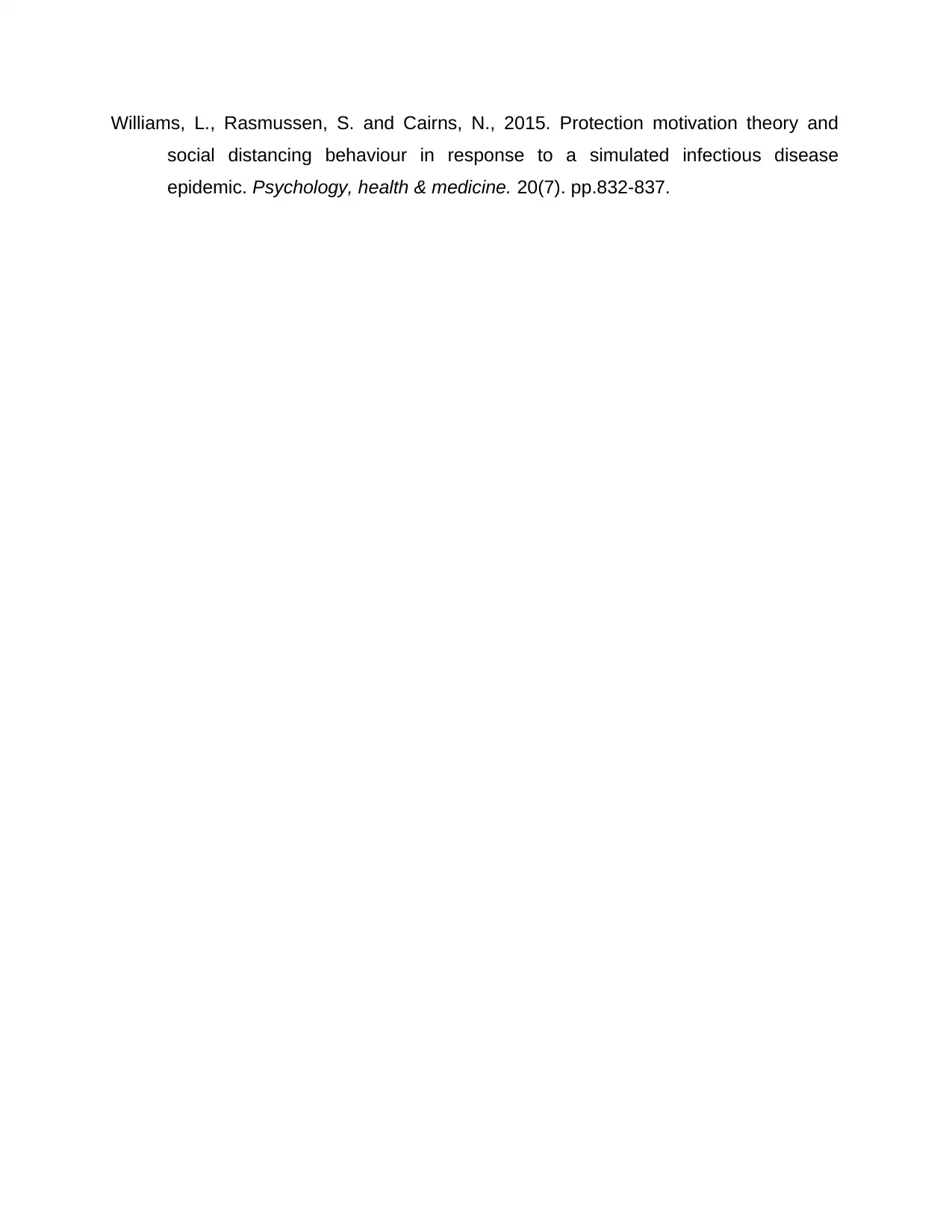
Williams, L., Rasmussen, S. and Cairns, N., 2015. Protection motivation theory and
social distancing behaviour in response to a simulated infectious disease
epidemic. Psychology, health & medicine. 20(7). pp.832-837.
social distancing behaviour in response to a simulated infectious disease
epidemic. Psychology, health & medicine. 20(7). pp.832-837.

⊘ This is a preview!⊘
Do you want full access?
Subscribe today to unlock all pages.

Trusted by 1+ million students worldwide
1 out of 12
Related Documents
Your All-in-One AI-Powered Toolkit for Academic Success.
+13062052269
info@desklib.com
Available 24*7 on WhatsApp / Email
![[object Object]](/_next/static/media/star-bottom.7253800d.svg)
Unlock your academic potential
Copyright © 2020–2025 A2Z Services. All Rights Reserved. Developed and managed by ZUCOL.




